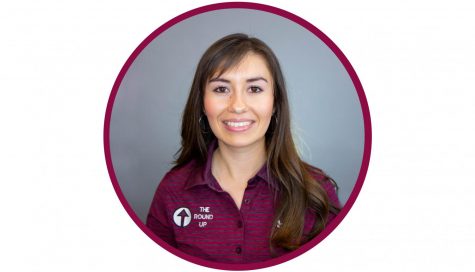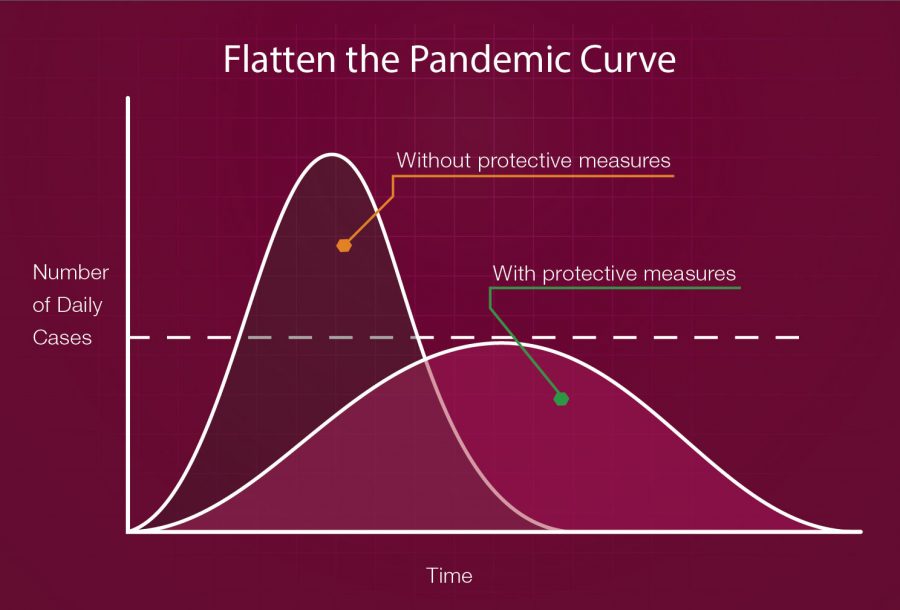Flattening the Curve: How to stop the spread of COVID-19 in New Mexico
This graph shows how putting protective measures in place can lower the number of COVID-19 cases.
“Social distancing” and “flatten the curve” have become phrases heard constantly in conversations surrounding the COVID-19 pandemic, but why are they important?
Jill McDonald, professor and associate dean of research and community engagement in the College of Health and Social Services at New Mexico State University, is an epidemiologist by training. She explained that the phrase “flatten the curve” refers to the standard technique of measuring the number of cases relative to the time that has passed in order to track the epidemic.
“In our sate we’re seeing the numbers of cases increase over time, so we know we’re on the upswing of an epidemic. We don’t know how high it’s going to go. We don’t know how quickly we can flatten it,” McDonald said.
McDonald said the idea is to stop the increase in case numbers as quickly as possible so that the progression of the epidemic slows and health workers can gain control over the virus. The U.S. is still seeing a significant increase in cases, as is New Mexico. On March 11, only three cases were reported in the state and all were travel related, meaning the people infected had recently traveled to states or countries where COVID-19 is prevalent. As of March 20, the state has reported 35 cases.
On March 19, the New Mexico Department of Health announced that they have detected community spread, meaning there are people who have become infected without evidence as to how they contracted it. The update explained, “the agency reports that given the infectious nature of the virus it is likely other residents are infected but yet to be tested or confirmed positive.”
While testing for the virus is continuing throughout the state, people are encouraged to only pursue a test if they are presenting symptoms such as fever and shortness of breath, or have recently traveled out of the state.
Drive-thru testing will be available in Las Cruces for people who meet these guidelines on March 20 at the Las Cruces Public Health Office parking lot from 9 a.m. to 3 p.m. and March 23 at the Burrell College of Medicine parking lot from 9 a.m. to 1 p.m.
The CDC outlines a variety of ways to practice social distancing for different people on their website. They emphasize that “the best way to prevent illness is to avoid being exposed to this virus.” To do this, they recommend keeping a distance of at least six feet between people and to stay home as much as possible.
In New Mexico, many precautions have been put in place at the state, city and university levels in an effort to contain the spread of Coronavirus. New Mexico Department of Health Secretary Kathy Kunkel announced March 19 further strict guidelines for people to follow, including the banning of gatherings of more than 10 people and the closure of many businesses such as malls, gyms and theaters. Grocery stores, pharmacies, shelters and hospitals are among the exemptions for the order.
“You can still call in an order for pick-up or home delivery from any restaurant that chooses to provide those services, and we strongly encourage you to find other ways to help keep local businesses like these afloat during these difficult times,” the update said.
Following similar precautions, NMSU has extended spring break, restricted the access to campus buildings and is in the process of moving classes online for the remainder of the semester.
“NMSU is restricting access to facilities to anyone who is not a student or employee. Corbett Center will remain open to allow students access to the Dining Hall, but the hours will be reduced. The U.S. Post Office will remain open,” NMSU President John Floros said in an email update March 18.
For more information about how NMSU is addressing the Coronavirus, call 575-646-7373. If you are presenting symptoms or have questions about the Coronavirus in general, call the NM Department of Health hotline at 1-855-600-3453.

Leah Romero is a native Las Crucen entering her fourth year at NMSU where she is pursuing a bachelor’s degree in Journalism and Media Studies along with...


Xavier • Mar 21, 2020 at 6:42 AM
Wrong Leah, you are not “Stoping” the spread of the virus you are only spreading over a longer period of time.
Both graphs with and without preventive measure have the same area, the same number of infections.